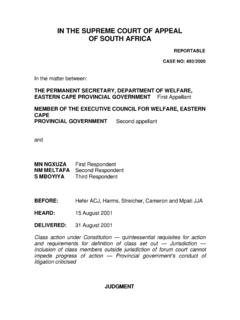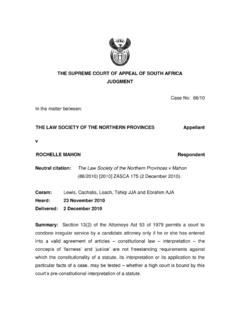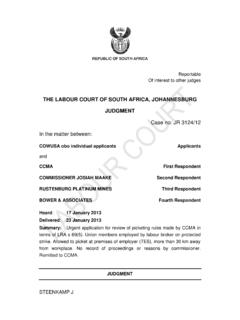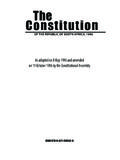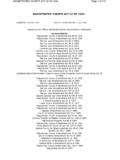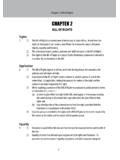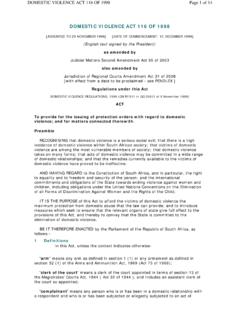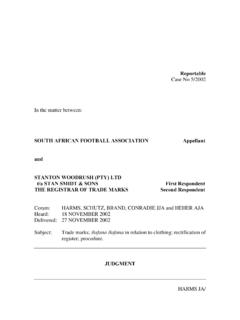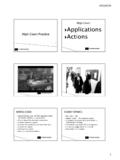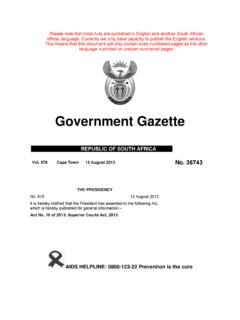Transcription of THE SUPREME COURT OF APPEAL OF SOUTH AFRICA …
1 THE SUPREME COURT OF APPEAL OF SOUTH AFRICA JUDGMENT Case No 475/10 In the matter between: BAREND STEPHANUS SMITH APPELLANT and THE STATE RESPONDENT Neutral citation: Smith v S (475/10) [2011] ZASCA 15 (15 March 2011) Coram: CLOETE, MAYA JJA and PLASKET AJA Heard: 3 March 2011 Delivered: 15 March 2011 Summary: Criminal Procedure APPEAL against a refusal to grant leave to APPEAL on petition Issue to be decided is whether the appellant has reasonable prospects of success on APPEAL , and not the merits of the APPEAL Reasonable prospects of success present if a sound, rational basis exists for the conclusion that the appellant has prospects of success on APPEAL . 2_____ ORDER _____ On APPEAL from: Eastern Cape high COURT (Grahamstown) (Jansen and Pickering JJ) (sitting as a COURT of APPEAL ).
2 1. The APPEAL is upheld and the order of the COURT below is set aside. 2. The order of the COURT below is replaced with the following order: The appellant is granted leave to APPEAL against his convictions to the Eastern Cape high COURT , Grahamstown. JUDGMENT PLASKET AJA (CLOETE and MAYA JJA concurring): [1] The appellant was convicted, in the Regional COURT , East London, of indecent assault and kidnapping. He was sentenced to seven years imprisonment, both counts being taken together for purposes of sentence. He applied to the trial magistrate for leave to APPEAL against both conviction and sentence. He was granted leave to APPEAL against sentence only. He then applied, by way of petition to the Judge President of the Eastern Cape high COURT , Grahamstown in terms of s 309 of the Criminal Procedure Act 51 of 1977, for leave to APPEAL against his conviction. His petition was dismissed.
3 With the leave of the judges who refused the petition (Jansen and Pickering JJ) he now appeals to this COURT against the dismissal of the petition. [2] This COURT held in S v Khoasasa1 that a refusal of leave to APPEAL on petition to two judges of a high COURT is a judgment or order or a ruling as contemplated by s 20(1) and s 21(1) of the SUPREME COURT Act 59 of 1959; that a petition for leave to APPEAL to the high COURT is, in effect, an APPEAL against the refusal of leave to APPEAL by the COURT of first instance; and that a 1 2003 (1) SACR 123 (SCA) paras 14 and 19-22. 3refusal of leave to APPEAL by the high COURT is appealable to this COURT with the leave of the high COURT . [3] In Matshona v S2 this COURT endorsed the reasoning in Khoasasa, describing it as unassailable . The COURT proceeded to emphasise that the issue to be determined at this stage is whether leave to APPEAL should have been granted by the high COURT and not the APPEAL itself.
4 3 As a result, the test to be applied is simply whether there is a reasonable prospect of success in the envisaged APPEAL .. rather than whether the APPEAL .. ought to succeed or not .4 [4] It was argued by counsel for the appellant that the test of reasonable prospects of success means and I quote from his heads of argument that leave should only be refused where there is absolutely no chance of success or where the COURT is certain beyond reasonable doubt that such an APPEAL will fail . In argument he articulated the test as being that if there was a possibility of success on APPEAL , leave must be granted. [5] Both of these submissions are incorrect and neither is supported by the cases cited by counsel. The first, R v Ngubane & others,5 is to the opposite effect. In that case, the COURT said the following:6 It was for the applicants to satisfy the COURT that there was a reasonable prospect of success on APPEAL if leave were granted.
5 When in Rex v Nxumalo (1939 AD 580 at p588), the present Chief Justice stated that there was no probability of the applicant succeeding , that did not mean, of course, that he had merely failed to show that there was a balance of probabilities in his favour. That test would obviously place too heavy a burden upon the applicant. Equally clearly, when Lord De Villiers CJ, in Rex v Gannon (1911 AD 269 at p270), spoke of the APPEAL as hopeless , or Innes CJ, in Rex v Mahomed (1924 AD 237 at p238), referred to the possibility of success , they did not mean that leave will only be refused where the APPEAL is hopeless or where the COURT is certain beyond all reasonable doubt that the APPEAL would fail. In all the cases, no matter what form of words was used, the same thing was, in my opinion, 2 [2008] 4 All SA 69 (SCA) para 4. 3 Para 5. 4 Para 8. 5 1945 AD 185. 6 At 186-7.
6 4intended to be conveyed, namely, that it is for the applicant for special leave to satisfy the COURT that, if that leave be granted, he has a reasonable prospect of success on APPEAL . [6] In S v Ackerman & 'n ander,7 cited in support of the second proposition set out above, the sentence of the English headnote from which counsel quoted, if taken out of its proper context, does not reflect correctly what was held in the body of the judgment. The Afrikaans headnote is similarly misleading. The COURT quoted with approval8 what had been held in S v Shabalala9 to be the correct approach to the granting of leave to APPEAL , namely:10 Omstandigheidsgetuienis kan sterker wees as 'n onbetroubare ooggetuie, en die moontlikheid dat die Hof van App l 'n moontlike fout in die beredenering sou kon vind en miskien tot die konklusie kon kom dat die verhaal van die beskuldigde waar kan wees, is so 'n anemiese toets dat 'n aansoek vir verlof in enige saak daarop sou kon slaag.
7 Alleen dan wanneer die Verhoorregter tot 'n weloorwo konklusie kom dat daar gronde is waarop die Hof van App l tot 'n ander afleiding van die feite kan kom as wat hy gekom het, en daar dus 'n redelike moontlikheid van sukses vir die applikant bestaan, behoort verlof toegestaan te word. Bestaan daardie moontlikheid, behoort verlof ook toegestaan te word sonder huiwering of te sin. [7] What the test of reasonable prospects of success postulates is a dispassionate decision, based on the facts and the law, that a COURT of APPEAL could reasonably arrive at a conclusion different to that of the trial In order to succeed, therefore, the appellant must convince this COURT on proper grounds that he has prospects of success on APPEAL and that those prospects are not remote but have a realistic chance of succeeding. More is required to be established than that there is a mere possibility of success, that the case is arguable on APPEAL or that the case cannot be categorised as hopeless.
8 There must, in other words, be a sound, rational basis for the conclusion that there are prospects of success on APPEAL . 7 1973 (1) SA 765 (A). 8 At 768D-E. 9 1966 (2) SA 297 (A). 10 At 299C-D. 11 S v Mabena & another 2007 (1) SACR 482 (SCA) para 22. 5 [8] The appellant s argument is that there are indeed reasonable prospects of success on APPEAL because the magistrate misdirected himself in various ways. In broad terms, the following are the major misdirections alleged to have been committed by the magistrate: first, even though the magistrate stated that the complainant s evidence had to be approached with caution, his evaluation of the evidence showed that he did not do so because the corroboration that he relied on was insufficient and the complainant could not be said to have been a satisfactory witness; secondly, he failed to take into account, when evaluating the evidence of the complainant, that during the events giving rise to the charge against the appellant, she had lied on a number of occasions, and that her explanations for doing so, with one possible exception, had not been considered; thirdly, a number of contradictory answers given by the complainant on various issues were not taken into account and properly evaluated by the magistrate.
9 And fourthly, the magistrate had convicted the appellant purely on the probabilities and had made no credibility findings of any sort against him that could have justified a conclusion that his evidence was not reasonably possibly true. In addition, the magistrate s finding that the report made by the complainant to her boyfriend and his father, on her arrival at their house, is strong confirmation of her version that she had been indecently assaulted is a misdirection, although the magistrate s reliance on her distressed state is On the other hand, however, there are without question facts and probabilities that point to the appellant s guilt. [9] In my view, and without wishing to comment on the merits in any detail, the alleged misdirections that have been listed above can be said to be sufficiently weighty to justify a conclusion that, if leave to APPEAL is granted, the appellant s prospects of success are reasonable.
10 In the result, the APPEAL must succeed. 12 See S v Hammond 2004 (2) SACR 303 (SCA). 6 [10] The following order is issued: 1. The APPEAL is upheld and the order of the COURT below is set aside. 2. The order of the COURT below is replaced with the following order: The appellant is granted leave to APPEAL against his convictions to the Eastern Cape high COURT , Grahamstown. _____ C. PLASKET ACTING JUDGE OF APPEAL 7 APPEARANCES APPELLANT: T N Price instructed by Changfoot and Van Breda, East London and Symington De Kock, Bloemfontein RESPONDENT Z Mdolomba of the office of the Director of Public Prosecutions, Grahamstown
